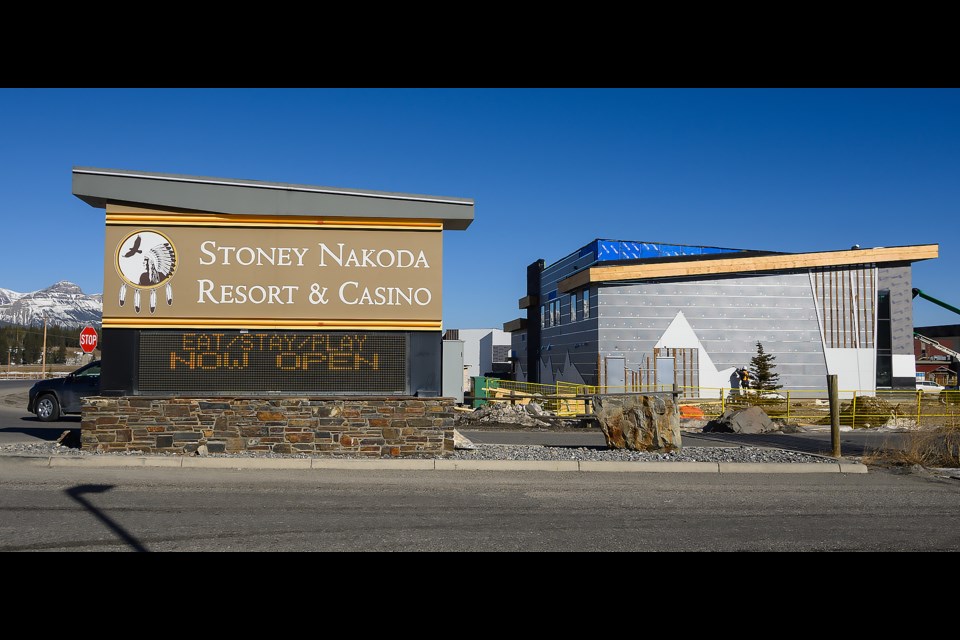STONEY NAKODA – The Stoney Nakoda Resort and Casino is developing a revised master plan that incorporates much-needed potential housing developments, increased retail services, a cultural centre, and expanded outdoor recreation and transit opportunities.
The master plan covers about 97 hectares of Îyârhe (Stoney) Nakoda First Nation land surrounding the current Stoney Nakoda Resort and Casino, also home to the Bearspaw Kananaskis Travel Centre and Goodstoney Meadows – another gas bar and retail centre set to open in the summer.
“What we’re really doing is building a regional project that ticks so many boxes, not just for the [Bow Valley] corridor but for the province as a whole,” said Brian Lee, CEO of the Stoney Nakoda Resort and Casino in a presentation to Kananaskis Improvement District (KID) council March 21.
“When you look at our plan and some of the characteristics, first and foremost, it’s First Nations-focused. We’re trying to address housing and labour, which is a big issue right now. There’s transportation, sustainability, and there’s environmentally friendly aspects of this project in terms of reducing carbon footprint.”
Importantly, he noted, it also has the support of all three Îyârhe Nakoda First Nation chiefs and councillors representing Chiniki, Bearspaw and Goodstoney First Nations.
“They’ve approved our process to go forward, restart the master plan process, look for the proper consultants to guide us through this and help us develop a plan,” said Lee. “[They’re] helping to identify some funding sources as well.”
The core of the plan is to create a population focused around the resort with staff and third-party housing which supports not only jobs and economic development for the First Nation, but also addresses housing and labour shortages throughout the Bow Valley.
Last month, Chiniki CEO Brian Evans told the Outlook that Chiniki band members alone currently face a waitlist of about 250 people for housing on the Nation. Raymond Greenwood, CEO of Goodstoney Nation, said they could use nearly that many houses just to fill the need for the Goodstoney community, and waitlist figures are believed to be just as long for Bearspaw Nation.
Much like the rest of the Bow Valley, Lee noted the Nation-owned Stoney Nakoda Resort and Casino is also struggling with labour shortages. By focusing on the need for affordable housing in the area, and providing other employment opportunities as well as amenities, he is hopeful shortages will fill.
“Our ability to recruit is challenged for lots of different reasons,” said Lee. “So, we have to look at what can we do? ... It’s difficult to find workers when everybody’s fighting over the same labour pool.
“There’s also not a lot of affordable housing in the Bow Valley right now, so we looked at that as an opportunity, we looked at that as one of our two core business models.”
To attract and retain workers, while also supporting the economic development of the Nation, the plan includes supplemental commercial developments such as a grocer, restaurants, medical and other professional services, as well as cultural and recreational activities with a multi-use arena, cultural centre, and theatre, in addition to amenities already offered at the resort and casino.
“We’re looking to create our own gravity population and we’re looking to create our own traffic drivers to the site so that we aren’t just relying on interceptor models,” said Lee.
Moving forward, Lee said, the resort needs to enlist a consultant to help formulate the plan and conduct feasibility studies, but all initial signs are pointing toward ‘go.’
The plan also prioritizes building a transit hub and more parking off Highway 40, near the gateway to K-Country.
Excitement around the table at KID council was palpable at the prospect of aligning a vision for public transit to also help ease traffic and environmental strain through the Kananaskis corridor.
Coun. Claude Faerden said he sees real potential for economic development centred around the resort to extend, as a bonus, into K-Country.
“I don’t feel that our valley has gotten the attention it deserves in the sense of our economic contribution to the province’s tourism industry,” he said. “I think there’s so much synergy in [this] plan with getting visitors into Kananaskis through some of your hubs and providing these employees places to live.”
As a resident of Kananaskis, Coun. Anita Szuster said the idea of simply having more services closer to the municipality’s relatively remote population is exciting.
“The prospect of having other amenities so close to home is very exciting,” she said.
As far as a timeline to implement the plan, Lee said there is still much work to do with initial discussions with consultants likely to take somewhere between six to nine months.
Lee said the master plan is still being fine-tuned and a request for proposal will go out for land management consultation by early May. Upcoming feasibility studies will also be crucial to providing economic justification for the plan.
“When we look for the funding mechanisms … We need to show that we’ve done studies showing there is demand for housing and potentially for mass transit,” he said.
The Local Journalism Initiative is funded by the Government of Canada. The position covers Îyârhe (Stoney) Nakoda First Nation and Kananaskis Country.




